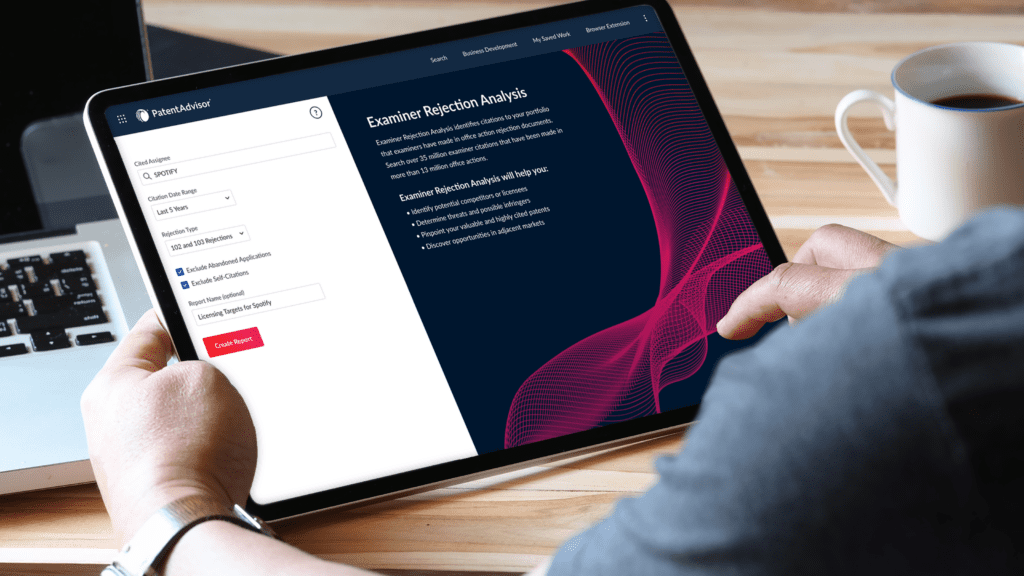Re-envisioning IP Monetization by Leveraging Examiner Citation Data

In today’s fast-paced and competitive business landscape, intellectual property (IP) has emerged as a crucial asset for companies seeking a competitive edge. As innovation becomes increasingly vital to success, protecting and leveraging one’s intellectual property has become a top priority. Recent events like the COVID-19 pandemic have impacted the rate of innovation in certain technology areas and caused a rise in the share of intangible assets, which now make up a staggering 90% of the market value of the S&P500. However, many organizations still view IP management as a cost activity, focusing primarily on the expenses associated with obtaining and maintaining patents.
To truly capitalize on the hidden potential of IP, businesses need to shift their perspective and recognize the value hidden in their portfolios. This paradigm shift involves understanding how to monetize patents effectively. While elaborate licensing searches and post-mortem litigation are traditional avenues of IP management, there is a lesser-known and often overlooked approach that holds immense value: examiner citation analysis. In this blog, you will learn how citation data can jumpstart your patent monetization machine.
IP monetization: the hidden value and unique challenges of working with examiner citations
Examiner citations are references to prior art documents that patent examiners use to assess the novelty and non-obviousness of a claimed invention. Analyzing the citations received by a portfolio can provide valuable insights for spotting the most valuable patents in it. If you are an IP professional tasked with finding patent monetization opportunities in a portfolio, this data can guide you to the solution to your problems. Whether you work for a leading law firm or in the IP department of a technology leader, finding more ways to make money from an existing patent portfolio will be a skill your stakeholders appreciate
While examiner citation data is a treasure trove of valuable information, accessing and processing this data is challenging. The United States Patent and Trademark Office (USPTO) provides examiner citation data, but it is often presented in an unstructured format that may not be analysis-ready. Extracting meaningful insights from this data requires significant effort and expertise in data collection, cleaning, and processing. Moreover, the sheer volume of data can be overwhelming, making it essential to employ trained experts, sophisticated analytics tools and methodologies to uncover actionable intelligence.
Citation data unlocks portfolio value for efficient IP monetization
Addressing one of the most pertinent challenges of IP professionals, we released the PatentAdvisor Examiner Rejection Analysis to address the pains of working with examiner citation data for the IP community. The primary reason behind building this feature was to address the need to easily spot companies that cite patents in a portfolio, thereby revealing potential licensing opportunities of companies interested in the underlying technology. If such valuable patents are not being used commercially by your company, these can be sold off to interested third parties and thus generate income for the business. And if multiple companies are citing this patent, you may even be able to start a bidding war and generate even more revenue.
Apart from such obvious monetization opportunities, insights from our examiner citation analysis will enable you to:
- Maximize the value of your IP: Gain leverage during a licensing negotiation by knowing if the patent currently being negotiated on has received examiner citations from multiple patents owned by the company you are negotiating with. Such citation patterns usually indicate that the technology protected by your patent is valuable to the competitor’s business. This insight provides decision makers the upper hand to make informed decisions regarding their IP and strategically leverage the strongest inventions.
- Protect your IP: Proactively monitor patents and spot potential infringers to protect your technology from unauthorized use, by finding out which competitors have been stopped due to an existing prior art in your or your client’s portfolio.
- Stay ahead of the competition: Since we update our database regularly, you can use recent citation data to keep track of any new entrants or interlopers in the same technical space. Imagine the feeling of being the first one to discover a new entrant in your client’s market and alert them of this.
- Discover blue oceans: Find untapped markets that are traditionally deemed unviable for your or your client’s business. If your (or the client’s) patents received citations from companies in a totally different market, it could suggest a potential opportunity for using the technology you already own to address an existing business need in this new market.
Beyond IP Monetization: Transforming the IP department into a profit center
Every IP department may function differently. Still, most suffer from the unfortunate stereotype of being a cost center and are often considered a liability despite being the protectors of the company’s most valuable assets. Citation analytics brings an end to all of this by delivering readily actionable insights that offer strategic leverage useful in competitive situations.
As mentioned earlier, the potential of examiner citation analysis to revolutionize the way IP professionals work extends far beyond patent monetization in terms of finding licensing partners. It is transforming the role of patent professionals from an operational role into a more strategic one. By harnessing the power of citation analytics, you can drive revenue generation and guide management in making informed decisions about their IP assets.
If you work at a company with a relatively extensive patent portfolio or at a law firm focusing on managing portfolios of technology companies, you should look into citation analytics to find the opportunities hidden in the portfolio(s) you manage.

Find patent licensing opportunities based on examiner citation analytics
Proactively identify licensing opportunities, infringement risks, and ways to maximize portfolio value with the new PatentAdvisor™ Examiner Rejection Analysis. Find out how you can leverage the powerful insights derived from 20+ years of 102 and 103 rejection data.
